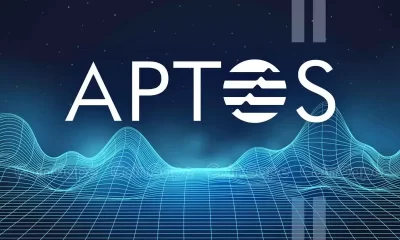business
Solana’s Tensor Teases Social Trading App to Rival Pump.fun
Published
5 months agoon
By
admin

Tensor, the Solana-based NFT marketplace, teased more details about its latest venture: Vector.fun, a new platform that will blend social engagement with token trading in a mobile-first app across multiple blockchain networks.
The company’s founders shared details about the trading platform on social media on Tuesday, emphasizing that its development spun out of NFT fatigue and the market’s attention becoming “tokenized memetic.”
“We saw an explosive new market emerge out of nowhere and we realized it was going to be the horse of this cycle. We knew we had to go in and win,” said Tensor co-founder Ilja Moisejevs on Twitter (aka X). “Just like early NFTs—there was no shortage of trading products… and just like early NFTs—they all sucked. We thought we could do better. So we imagined a 10x experience,” he posted.
The platform, which has been in private beta for the last few months, aims to redefine trading by combining it with social interaction in a SocialFi experience. In other words, Tensor aims to put the meme coin banter, flexing, and community-building all in one spot.
“Trading crypto with your internet friends and bonding over the latest meme is SocialFi. Building a great social trading experience is SocialFi. Vector is SocialFi,” said co-founder Richard Wu.
A waitlist for early access was open for a brief period early this week, but intense demand forced the team to discontinue signups. Waitlisted parties are expected to get a chance to use Vector.fun in the next few weeks as the team gradually rolls out access. Holders of the company’s NFT collection, Tensorians, can skip the waitlist by confirming ownership via Discord.
Tensor rose to prominence in the late stages of 2023, stealing Solana NFT trading volume from Magic Eden while achieving a market share as high as 85.2% in January 2024, according to data from Andrew Hong’s Solana NFT marketplace Dune dashboard.
Upon launch, Tensor’s Vector.fun will enter a highly competitive space and compete directly with notable meme coin trading terminals like Photon, BullX, and Jupiter’s ApePro, which have gained notoriety for their trading speed and meme coin discoverability.
Meme coin trading, particularly on Solana, has been on fire this year. That’s been led in large part by the Solana meme coin factory Pump.fun, which made it cheap and easy for just about anyone to launch a new token.
Since the start of the year, users on Pump.fun have created more than 3 million new meme coins, according to data on Dune. A few of those tokens—such as Peanut the Squirrel (PNUT) and Goatseus Maximum (GOAT)—have grown to sizable market caps and earned early entrants considerable gains.
Trading meme coins, though, comes with hefty risks, as most new tokens die quick deaths. The biggest winners of the meme coin craze are arguably the trading platforms that host them. Pump.fun, for instance, has so far earned more than $180 million in revenue from degens creating and flipping tokens.
Will Tensor be able to take on the incumbent and get a slice of that pie? It’s done it before.
Edited by Guillermo Jimenez and Andrew Hayward
Daily Debrief Newsletter
Start every day with the top news stories right now, plus original features, a podcast, videos and more.
Source link
You may like


AVAX Falls 2.1% as Nearly All Assets Trade Lower


What is a VTuber, and how do you become one in 2025?


Top Expert’s Update Sets $10 Target


How Academia Interacts With The Bitcoin Ecosystem


AB DAO and Bitget Launch Dual Reward Campaign, Distributing $2.6M Worth of $AB Globally


AI crypto tokens at risk as Nvidia faces restrictions on China exports
business
Strategy Buys More Bitcoin as Tariff Exemptions Send Tech Stocks Soaring
Published
2 days agoon
April 14, 2025By
admin

Strategy, formerly known as MicroStrategy, acquired around 3,450 Bitcoin worth $286 million last week, the company said in a Securities and Exchange Commission filing.
Unveiling a Bitcoin purchase for the third straight Monday, the Tysons, Virginia-based firm now owns 531,644 Bitcoin worth $45.2 billion, based on the asset’s current price.Strategy paid an average price of $82,600 per Bitcoin last week, it added.
Strategy, which has shifted its focus from software development to become a Bitcoin treasury, said it meanwhile sold one million Class A common shares through an at-the-money offering program unveiled in October. Under the initiative, Strategy said it can still issue an additional $2 billion worth of common shares, alongside swaths of preferred perpetual stock.
Strategy’s shares rose 4% on Monday to around $312, as the tech-heavy Nasdaq surged 1.5%, adding on to last week’s recovery after the White House said smartphones and computers would be exempt from sweeping levies, including 125% taxes on Chinese goods, per Nasdaq.
Monday’s price action represents a dramatic turnaround after investors navigated outsized uncertainty last week, including a disclosure from Strategy that it may ultimately need to sell Bitcoin to meet its financial obligations. Amid tariff-linked concerns, Strategy’s shares fell as low as $236, or around 32% below their opening on Monday.
“No Tariffs on Orange Dots,” Strategy co-founder and Executive Chairman Michael Saylor said on X, formerly Twitter, on Sunday, referring to the way Bitcoin buys look on Saylor Tracker.
The price of Bitcoin was recently changing hands around $85 on Monday, showing a roughly 8.3% increase of the past week, according to CoinGecko. Over the past month, it’s virtually flat.
Strategy has become the world’s largest corporate holder of Bitcoin since it began accumulating the asset in 2020. Over time, as it has embraced its role as a Bitcoin treasury firm, Strategy has issued billions of dollars in debt to buy more Bitcoin than it could otherwise.
The Nasdaq-listed firm’s 531,600 Bitcoin tower over the next largest corporate holder, Bitcoin miner Marathon Digital, which is around 47,500 Bitcoin, according to Bitcoin Treasures. As of this writing, Strategy’s stash accounted for more than 2.5% of Bitcoin total supply.
The Tokyo-based investment firm Metaplanet, which began buying Bitcoin last May, said on X on Monday that it had recently bought 319 Bitcoin worth $27 million. The company said in an update that it now holds 4,525 Bitcoin worth around $385 million.
Among publicly traded companies, MetaPlanet is currently the 10th largest Bitcoin holder, according to Bitcoin Treasuries.
Edited by James Rubin
Daily Debrief Newsletter
Start every day with the top news stories right now, plus original features, a podcast, videos and more.
Source link
business
Japan’s Metaplanet Buys Another $26M in Bitcoin Amid Tariff Market Uncertainty
Published
2 days agoon
April 14, 2025By
admin

Metaplanet, the Tokyo-listed firm dubbed “Asia’s MicroStrategy,” has boosted its Bitcoin holdings with a fresh 3.78 billion yen ($26.3 million) purchase amid growing tension over U.S. trade tariffs.
The company said it acquired 319 BTC at an average price of 12,849,780 yen ($82,549) per coin, bringing its total holdings to 4,525 BTC. Metaplanet plans to boost its Bitcoin holdings by 470%, targeting a total of 10,000 BTC by year-end.
The timing of the purchase comes as digital assets falter under geopolitical pressure. Bitcoin dropped more than 2% on Sunday during Asia trading hours, sliding to $83,482 as investors digested conflicting signals from Washington over the direction of U.S. trade policy toward China.
Traditional markets remained resilient despite a flurry of comments from the Trump administration regarding new tariffs on Chinese electronics. Nasdaq 100 futures rose over 1% in early trading, while S&P 500 futures climbed 0.7%.
While smartphones and semiconductors were temporarily excluded from a proposed 10% “reciprocal” tariff, President Trump clarified late Sunday on Truth Social that the same products will remain subject to a separate 20% national security levy.
Commerce Secretary Howard Lutnick said further sector-specific tariffs are expected within the next two months.
By Monday, 1 a.m. ET, Bitcoin was up just 0.4% over the last 24 hours, trading at $84,990, according to CoinGecko. Ether was up 1.8% to $1,638 over the same period. The top ten cryptocurrencies by market cap have all posted slight gains or no change.
Metaplanet has leaned heavily into Bitcoin as its core treasury asset. Last month, the company appointed Eric Trump, son of the U.S. president, to its newly formed Strategic Advisory Board, citing his “business expertise and passion for Bitcoin.”
Metaplanet is positioning itself in the mold of Michael Saylor’s Strategy, whose aggressive Bitcoin accumulation strategy has influenced a growing number of publicly listed firms to follow suit.
At the same time, the Trump administration has launched two separate initiatives: a Strategic Bitcoin Reserve, funded by seized BTC and held as a permanent national asset, and a U.S. Digital Asset Stockpile, which includes other confiscated crypto with potential for liquidation or strategic use.
Edited by Sebastian Sinclair
Daily Debrief Newsletter
Start every day with the top news stories right now, plus original features, a podcast, videos and more.
Source link
business
Scottish School Will Accept Bitcoin Payments, May Launch BTC Reserve
Published
4 days agoon
April 12, 2025By
admin

A school in Scotland has said it will be the first in the UK to start accepting Bitcoin payments.
Lomond School in the town of Helensburgh said that it made the choice to accept the cryptocurrency after a number of parents—both local and foreign—made the request, The Times reported.
The private boarding school has a number of international students.
To “manage and mitigate risk,” the school said it would start accepting the biggest cryptocurrency in phases, and would convert digital coins received into pound sterling. It also said that it would ensure full compliance with UK financial regulations when accepting BTC.
The school added that it would also consider building a reserve of the cryptocurrency if its use case grows in the UK. “Assuming Bitcoin gains broader acceptance in the UK and worldwide, the school will look to build a Bitcoin asset reserve,” it said in a statement.
Lomond School did not immediately respond to Decrypt’s questions.
The idea of a “Bitcoin asset reserve” echoes U.S. President Trump’s executive order signed last month authorizing the government to hold BTC and figure out ways to buy more of the asset. The U.S. government already holds around 200,000 BTC—worth $16.7 billion at today’s price—that was primarily seized or forfeited in criminal cases.
A number of other countries are now considering holding Bitcoin—like they hold other assets in reserves—and businesses too have started buying up the asset. Strategy, the largest corporate holder of Bitcoin, currently holds over $44 billion worth of the asset.
Edited by Andrew Hayward
Daily Debrief Newsletter
Start every day with the top news stories right now, plus original features, a podcast, videos and more.
Source link

AVAX Falls 2.1% as Nearly All Assets Trade Lower

What is a VTuber, and how do you become one in 2025?

Top Expert’s Update Sets $10 Target

How Academia Interacts With The Bitcoin Ecosystem

AB DAO and Bitget Launch Dual Reward Campaign, Distributing $2.6M Worth of $AB Globally

AI crypto tokens at risk as Nvidia faces restrictions on China exports

Coinbase Urges Australia to Vote for Crypto Progress in May

How High Would Pi Network Price Go If Pi Coin Adopts Transparency to Avoid Mantra Pitfalls

XRP’s ‘Rising Wedge’ Breakdown Puts Focus on $1.6 Price Support

China selling seized crypto to top up coffers as economy slows: Report

Ethereum Price Dips Again—Time to Panic or Opportunity to Buy?

The Inverse Of Clown World”

Bitcoin Indicator Flashing Bullish for First Time in 18 Weeks, Says Analyst Who Called May 2021 Crypto Collapse

3iQ and Figment to launch North America’s first Solana staking ETF

Bitcoin Miners Are Selling More BTC to Make Ends Meet: CryptoQuant

Arthur Hayes, Murad’s Prediction For Meme Coins, AI & DeFi Coins For 2025

Expert Sees Bitcoin Dipping To $50K While Bullish Signs Persist

Aptos Leverages Chainlink To Enhance Scalability and Data Access

Bitcoin Could Rally to $80,000 on the Eve of US Elections

Crypto’s Big Trump Gamble Is Risky

Sonic Now ‘Golden Standard’ of Layer-2s After Scaling Transactions to 16,000+ per Second, Says Andre Cronje

Institutional Investors Go All In on Crypto as 57% Plan to Boost Allocations as Bull Run Heats Up, Sygnum Survey Reveals

Ripple-SEC Case Ends, But These 3 Rivals Could Jump 500x

3 Voting Polls Show Why Ripple’s XRP Price Could Hit $10 Soon

Has The Bitcoin Price Already Peaked?

A16z-backed Espresso announces mainnet launch of core product

The Future of Bitcoin: Scaling, Institutional Adoption, and Strategic Reserves with Rich Rines

Xmas Altcoin Rally Insights by BNM Agent I

Blockchain groups challenge new broker reporting rule

I’m Grateful for Trump’s Embrace of Bitcoin
Trending

 24/7 Cryptocurrency News5 months ago
24/7 Cryptocurrency News5 months agoArthur Hayes, Murad’s Prediction For Meme Coins, AI & DeFi Coins For 2025

 Bitcoin3 months ago
Bitcoin3 months agoExpert Sees Bitcoin Dipping To $50K While Bullish Signs Persist

 24/7 Cryptocurrency News3 months ago
24/7 Cryptocurrency News3 months agoAptos Leverages Chainlink To Enhance Scalability and Data Access

 Bitcoin5 months ago
Bitcoin5 months agoBitcoin Could Rally to $80,000 on the Eve of US Elections

 Opinion5 months ago
Opinion5 months agoCrypto’s Big Trump Gamble Is Risky

 Altcoins3 months ago
Altcoins3 months agoSonic Now ‘Golden Standard’ of Layer-2s After Scaling Transactions to 16,000+ per Second, Says Andre Cronje

 Bitcoin5 months ago
Bitcoin5 months agoInstitutional Investors Go All In on Crypto as 57% Plan to Boost Allocations as Bull Run Heats Up, Sygnum Survey Reveals

 Price analysis5 months ago
Price analysis5 months agoRipple-SEC Case Ends, But These 3 Rivals Could Jump 500x


